The Hazardous Waste Guide provides general guidance on waste disposal practices, and specific guidance for some of the more common waste types. This document belongs in Section 11 of your CHP.
Introduction
The Laboratory Hazardous Waste Management Guide was developed by the UTIA Safety Office and adapted from other universities with comparable lab safety programs. At UTIA, each lab is responsible for the management and disposal of hazardous materials. This guide is designed to help lab supervisors and personnel classify and dispose of wastes safely and in compliance with the U.S. Environmental Protection Agency (EPA) and Tennessee Department of Environment and Conservation (TDEC).
Questions regarding hazardous waste management at UTIA should be directed to the Safety Office at 974-4904.
Regulatory Authority
The management of hazardous waste is regulated by The Tennessee Department of Environment and Conservation (TDEC) and the U.S. Environmental Protection Agency (EPA). The respective regulations can be found in 40 CFR 260-268 and TDEC Rule 1200-1-11. The State of Tennessee has been given authority by the USEPA to administer hazardous waste regulations.
What is Hazardous Waste?
A waste is any material that is no longer wanted. Hazardous waste is any waste with properties that make it harmful to human health or the environment. Hazardous wastes can be in liquid, solid, gas or sludge form. EPA uses both chemical lists and waste characteristic definitions to determine if a waste is a hazardous waste. Wastes are hazardous due to flammability, corrosivity, reactivity, or toxicity.
Most chemical wastes on the Ag Campus are disposed of as hazardous wastes, and should be brought to the quarterly hazardous waste pickups at the Plant Biotechnology Building or the Veterinary School. These chemicals are then turned over to a contractor for final disposal.
Definitions of Hazardous Waste Characteristics from the EPA Resource Conservation and Recovery Act (RCRA)
Flammability
Flammable wastes will create fires under certain conditions, perhaps spontaneously combust, and have a flash point less than 60 °C (140 °F). Examples include waste ethanol, methanol, hexane, acetic acid and acetone.
Corrosivity
Corrosive wastes are acids or bases with a pH less than or equal to 2, or greater than or equal to 12.5. They are capable of corroding metal containers, such as storage tanks, drums, and barrels. Examples include used acetic acid and sodium hydroxide.
Reactivity
Reactive wastes are unstable under “normal” conditions. They can cause explosions, and/or reactive gases or vapors when heated, compressed, or mixed with water. Examples include picric acid waste (that has been allowed to crystallize), sodium azide, old tetrahydrofuran and old ethyl ether.
Toxicity
Toxic wastes are harmful or fatal when ingested or absorbed (e.g., pesticides, metals such as mercury or lead, and toxic chemicals such as nicotine, benzene, formaldehyde, chloroform, etc.). When toxic wastes are land disposed, contaminants may escape and pollute the air or ground water.
General Waste Management Guide
Any waste materials in a lab are the responsibility of the current principal investigator (PI). Important – Wastes may be left in a lab by other parties, or may be inherited from previous researchers when a lab transfers management. In either case it DOES NOT MATTER that the PI did not intend to create the waste; responsibility for labeling and disposing of all chemicals in a lab is the responsibility of the current PI. Any material that has no foreseeable use should be disposed of, given to another researcher, or submitted to UTIA Safety Office for chemical exchange.
Ensure that hazardous materials are never disposed of into regular solid waste (trash) containers, flushed down a drain or otherwise inappropriately disposed of. UTIA conducts quarterly waste pick-ups at each of the following two locations:
- Vet School hazardous waste is picked up at the anatomy loading dock, and
- the rest of the Ag Campus hazardous waste is picked up at the Plant Biotechnology Building loading dock
Several email notices are sent from the UTIA Safety Office when a hazardous waste collection day is coming up. If you would like to be added to the email notification list please contact the Safety Office.
Waste Storage Area
Prior to disposal, wastes should be stored in the lab in an area designated for hazardous waste storage. Often times, this is a space under the fume hood or a separate storage cabinet. Any waste storage area should be labeled with a sign that reads Hazardous Waste Storage Area, like the one shown in the picture below. Criteria for a good waste storage area include:
- Away from heat and sparks
- Protected from foot traffic/minimize risk of container tipover
- Does not block path of exit from lab, in case of a spill
- Flammable wastes should be stored in a flammable storage cabinet if possible
Hazardous waste labels, tags and storage area signs are available through the UTIA Safety Office.
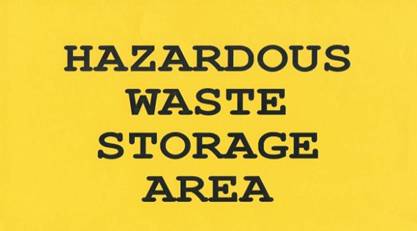
Waste Handling
Hazardous materials should be handled carefully. In order to protect all those who handle the materials, liquid wastes should be labeled and placed inside leak proof secondary containment. Likewise, dry solids should be placed in a puncture resistant tub or a sturdy box lined with a plastic bag to prevent leakage or spilling. If you can do so safely, bring the entire tub or tray to the waste collection site. If the load is especially heavy, use a cart to transport the items.
Consider additional containment for especially hazardous wastes. For example, when transporting highly toxic materials such as cyanides or osmium tetroxide place it inside a Ziploc bag before adding it to a tray or tub. A hazardous waste spill can be a major event. Any time a spill occurs, please contact the UTIA Safety Office immediately.
All waste containers should be “strong and tight.” Liquid waste containers should be securely closed, preferably with screw-top caps. Solids and gel waste containers should be strong enough to not fall apart in normal handling. Never use food containers to store hazardous waste (i.e. water bottles, juice and milk jugs, etc.).
Evaluate chemical compatibility before mixing different chemicals in a hazardous waste container. Some chemicals are not compatible, and if mixed they will react and generate heat, toxic gases, or explode. Also, liquid and solid wastes should be contained separately. For example, mixing toluene with benzene is safe and reasonable, but mixing concentrated perchloric acid or nitric acid with methanol can be disastrous. It is far better practice to bring several waste containers to the pickup than to bring one waste container that may be reacting. Check the MSDS for compatibility information.
If chemical smells are noticeable in the area, check to make sure the caps are tightly closed on all the waste bottles. Some wastes may react, generating gases that pressurize the waste bottle – sometimes enough to cause the waste bottle to explode (for instance nitric acid/organic waste mixtures or organic peroxide wastes). In these cases, use a venting pressure-relief cap to avoid pressure buildup and explosion. Contact the UTIA safety office to obtain a vented cap.
In all cases, ensure the storage container is compatible with the wastes stored in it. For instance, do not store acids which corrode metal in a metal container, and do not use a plastic bottle to store a solvent that may dissolve the plastic. Glass bottles are good general purpose containers for liquid wastes, with the exception of hydrofluoric acid which dissolves glass and must be stored in plastic containers.
Leave 1-2” of head space in liquid waste containers to allow for expansion in extreme weather and to reduce the potential for spillage.
Broken glassware and non-chemically contaminated sharps can be collected in a sturdy box and taken to the nearest dumpster. Do not discard broken glassware or sharps in the trashcan; the housekeeping staff has been cut when they’ve picked up trash bags containing sharps and glass. Chemically-contaminated sharps must be treated as hazardous waste and labeled accordingly.
All hazardous waste storage containers must be properly labeled. Complete the Hazardous Waste label or tag as thoroughly as possible (see picture below). As soon as the first drop of hazardous waste enters the container, apply the waste label and write the contents on the label. Do not put a date on the waste label (the date field is only used when a waste container is transferred out of the lab to a hazardous waste storage room, which is generally a Knoxville campus procedure).
Ensure the following information is displayed clearly
- Name
- Contact information
- Chemical name(s) spelled out and approximate proportion of each
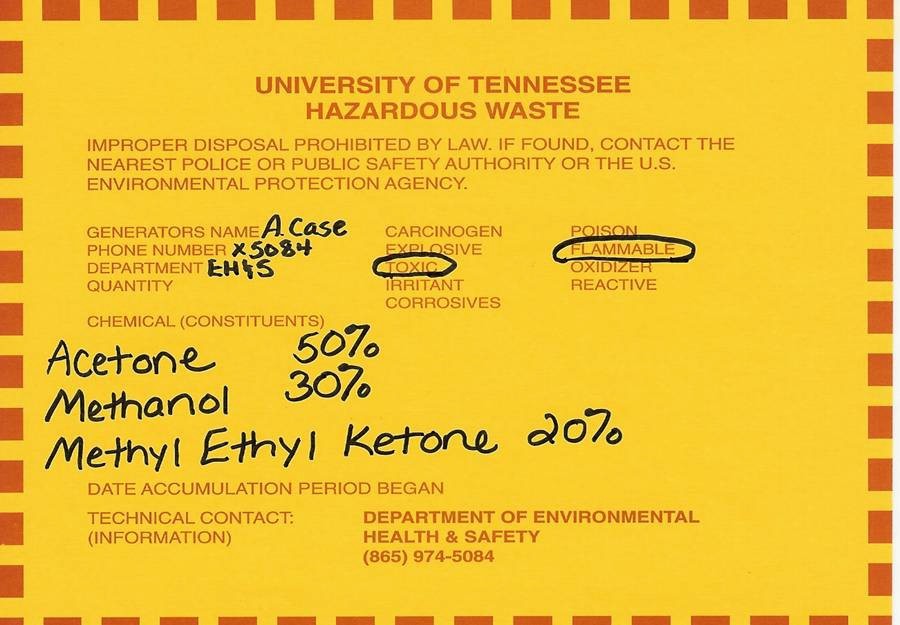
Waste containers must remain closed whenever not in use (i.e. unless someone is actively adding to the container, it must be closed). The closure must tightly seal the container, so that it will not leak if tipped over. Parafilm over the top of a container does not adequately close the container. Failure to label and close waste containers are violations of state and federal law and can result in fines to the University. Unlabeled and unclosed (open) waste containers are the two most common violations found when hazardous waste inspections are performed. Here are some examples of violations:
Examples of Open Containers:
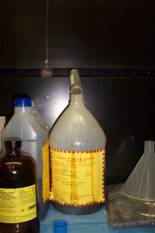
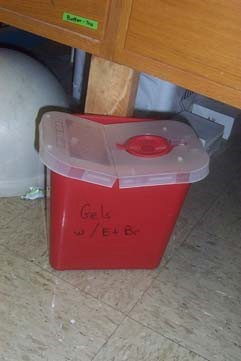
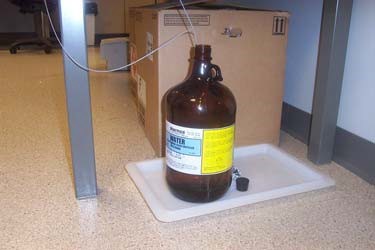
Examples of Insufficient Labeling:
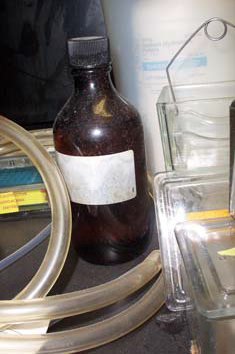
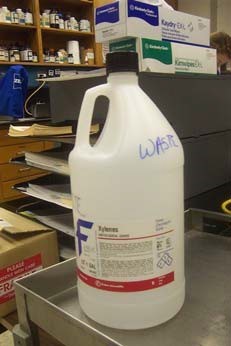
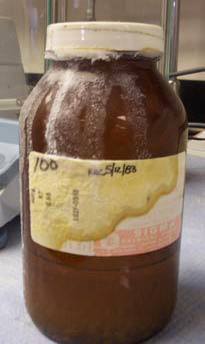
The size of the waste container should be based on the anticipated amount of waste that will be generated. Full waste bottles (filled to the neck of the bottle, with 1-2” of head space) are the most cost-effective for disposal. If a waste bottle is largely empty, continue to use it until it is full, or transfer the waste to a smaller bottle before bringing it to waste pick-up. However, if the waste contains highly toxic materials the risk of exposure or a spill during a transfer outweighs the cost-savings; for these wastes minimize transfers and handling of the material. If you are having trouble finding appropriately sized containers, contact the UTIA safety office for assistance.
Under no circumstances should radioactive materials be mixed with chemical hazardous wastes.
Unused material in the manufacturer’s original containers can be submitted as waste without a yellow hazardous waste sticker, as long as the original label is still attached and legible.
Please call the safety office if you have a large amount of chemicals for disposal, or are doing a lab cleanout. It is easier and safer to collect the material directly at the lab than to transport them to the waste pick-up area.
Disposal Guidance for Common Wastes:
Acid Solutions — It is acceptable for lab personnel to neutralize certain acid wastes if the waste does not contain other hazards (e.g. organics or metals). Some acids may not be neutralized and must be brought to hazardous waste collection for disposal (perchloric acid, concentrated nitric acid, concentrated sulfuric acid, chromic acid, hydrofluoric acid, and organic acids that are still toxic after neutralization).
Care must be taken to avoid mixing incompatible acids. Note the following incompatibilities and do not mix incompatible acids together:
- Acetic acid – incompatible with nitric acid, chromic acid, peroxides and permanganates.
- Chromic acid – incompatible with organics (including acetic acid)
- Hydrofluoric acid – incompatible with ammonia
- Nitric acid (concentrated) – incompatible with organics (including acetic acid); ignites on contact or reacts explosively
- Perchloric acid – extremely reactive with organics and metals; potential to form shock-sensitive and explosive compounds. Do not mix perchloric waste with any other wastes. Put it in an exclusive use container.
- Sulfuric acid – incompatible with chlorates, perchlorates, permanganates
Debris — Debris from cleaning up spills or leaks of hazardous material, such as contaminated towels, gloves and shelf paper, should be bagged and labeled as hazardous waste. Debris with incidental contact with the outside of the container and with no visible contamination can be discarded in the regular trash.
Empty Containers — A chemical container that is thoroughly emptied can usually be disposed of as regular trash if the following steps are taken:
- Write “Empty” on the container
- Do not put containers in the trash with hazard signage – deface markings by scraping off, covering with tape, or putting a thick X through them (a simple “slash” through the marking is insufficient)
- Triple rinse with water so that concentrated residue will not leak out
Some chemicals are so toxic that the empty containers cannot be thrown away in the normal trash. These EPA “acutely toxic” chemicals include cyanide compounds, acrolein, and many pesticides. For disposal of empty containers that held particularly toxic chemicals, contact the UTIA Safety Office for guidance or bring the unrinsed containers to the next hazardous waste pickup.
Ethidium Bromide Gels — Ethidium bromide (EtBr) gels should be collected in leak proof containers and affixed with a hazardous waste label or tag. Do NOT use biohazard bags (ethidium bromide is a chemical hazard – the hazardous waste contractor cannot legally accept biohazardous waste). Common ethidium bromide waste containers are disposable open top Ziploc-style containers, or doubled heavy-duty bags in a step-on can:
EHS does not endorse any particular brand of container.
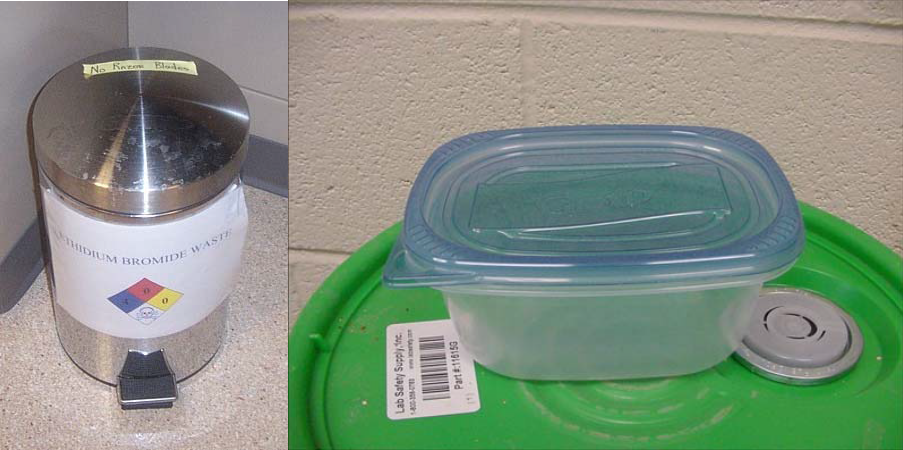
**Do not put tips or tubes in a bag, as these may puncture the bag in transport. Gels disposed of in a bag must not have any free liquid; and the bags should weigh no more than 25 pounds each.
Ethidium Bromide Solutions — Put ethidium bromide solutions in a strong tightly closed bottle. If the ethidium bromide has been filtered out of the solution, bring the filter matrix for disposal and pour the filtered solution down the drain. See the hazardous waste section at http://safety.ag.utk.edu/safetyplan/ for specific guidance on ethidium bromide filtration options.
Gas Cylinders — Gas cylinders should be returned to the gas supplier directly. If the gas supplier does not take a cylinder, contact the UTIA Safety Office.
Metallic Mercury — Metallic mercury should be double-contained, e.g. a bottle inside a Ziploc bag. This is a good practice for transporting mercury thermometers as well. Mercury is easy to spill and very hard to clean up.
Mercury Salts and Mercury Salt Solutions — Do not mix mercury and mercury salt solutions with other types of wastes, as the resulting waste is very expensive for disposal (the waste treatment process involves extra steps to remove the mercury). Whenever possible, keep all mercury salts and solutions separate for disposal, even when there are no compatibility issues.
Metal Solutions — Similar to mercury, do not mix metal solutions and metal salt solutions with other types of wastes, as the resulting waste is very expensive for disposal (because of the extra controls during the treatment process).
Organic Peroxides — Hydrogen peroxide and other organic peroxide solutions are reactive with organics and with many metals and can lead to fires or explosions. Waste solutions are known to generate gases that can cause over-pressurization and explosion of the waste container. Use vented storage caps available through the Safety Office for organic peroxide waste containers.
Organic Solutions — On the waste label, list the solvents and the relative levels of each. Collect halogenated organic wastes in a separate container from non-halogenated wastes. Below are three acceptable ways to describe the same waste:
- Benzene/Acetone/Xylene mixture 3:1:1,
- Benzene (60%), Acetone (20%), Xylene (20%), or
- Benzene (600 ml), Acetone (200 ml), Xylene (200 ml)
Packages/Deliveries with Leaking Chemicals — If a chemical arrives in a broken container there are two options:
- Decline acceptance of the shipment – the shipper is required to have a plan for addressing hazmat incidents for materials in commerce.
- Accept the shipment but make a note on the bill of lading that the container is broken. Place the material inside a fume hood and contact the vendor to initiate their procedure for collecting hazardous waste from our site (for Fisher Scientific, they have a hazardous waste contractor that will come pick up the waste). If you have any questions or are unsure of what to do, please call the UTIA Safety Office.
Perchlorates — Extremely reactive with metals and organics, including wood and paper; have the potential to form shock-sensitive and explosive compounds. Do not mix perchloric waste with any other wastes. Put it in an exclusive use container.
Phenol/Chloroform — Tips and tubes contaminated with residual phenol/chloroform solutions (by EPA definition, if the container has 3% of more residual content it is not empty) should be collected in a strong and tight container, or a double-bagged arrangement. Do not allow the chloroform to evaporate in the fume hood. Always close the waste container when not in use.
Collect phenol/chloroform liquid mixtures in a strong and tight container and label with a hazardous waste label. Extra care should be taken in handling this waste, as contact with phenol causes chemical burns that may be more serious than they initially appear, due to phenol’s anesthetic effect. Chloroform will evaporate rapidly and accumulate in enclosed areas, such as a non-vented cabinet, creating an inhalation hazard.
Halogenated Compounds — Separate halogenated organic compounds into a separate waste container from non-halogenated organic waste (disposal of halogenated compounds is more expensive due to extra treatment steps to remove the halogens).
Sharps — Chemically contaminated sharps should be collected in a puncture proof container that cannot be red and cannot have a biohazard symbol (the hazardous waste contractor cannot legally accept biohazard waste). Containers should be closed and not overfilled. Label the container with a hazardous waste label that lists the chemical(s) that the sharps are contaminated with (for example “sharps contaminated with hygromycin B”).
Unknown Materials — Occasionally materials with degraded or missing labels, or inherited containers without a label, are discovered. Contact the UTIA safety office as soon as possible for a consultation. If there is enough information to identify and classify the material, it avoids the unnecessary risk, testing, and the expense of disposing of the material as an unknown chemical.
Unwanted Reagents — As reagents get old, become deteriorated, or no longer serve a purpose, they become waste. These may or may not be opened. Usually these items have an expired shelf life, or are leftovers from research that is no longer being done. It is good practice to dispose of or recycle (give to another researcher or to EHS) any reusable material that your lab does not have a plan to use.
As noted above, these materials do not need a waste label if their original manufacturer labels are intact and readable.
Vacuum Pump Oils — Vacuum oils can be disposed of at the quarterly waste pick up. The oils may be used or unused. Do not mix solvents in with the oil (oils are usually recycled and solvents are usually incinerated).